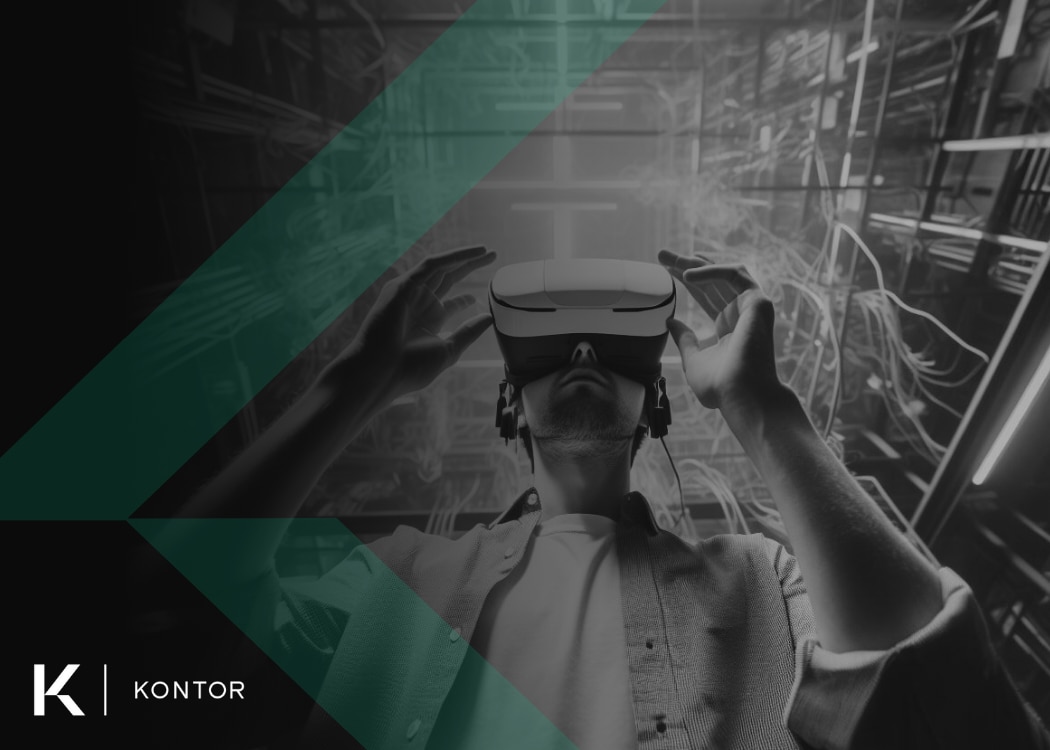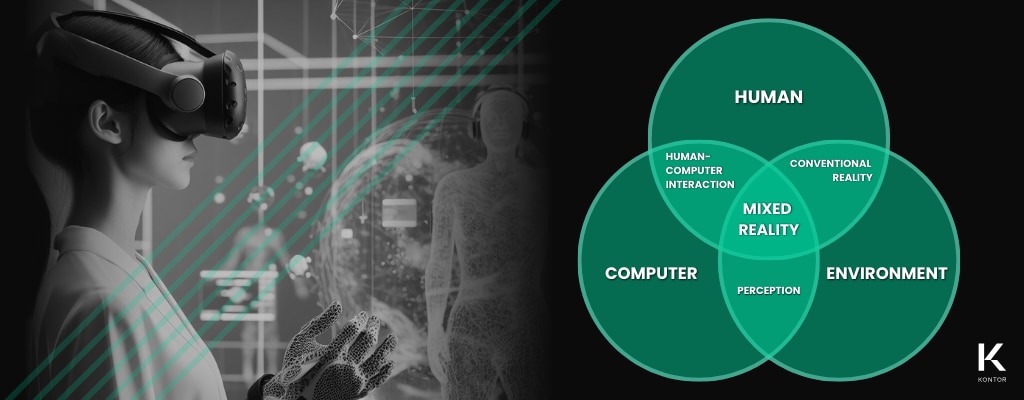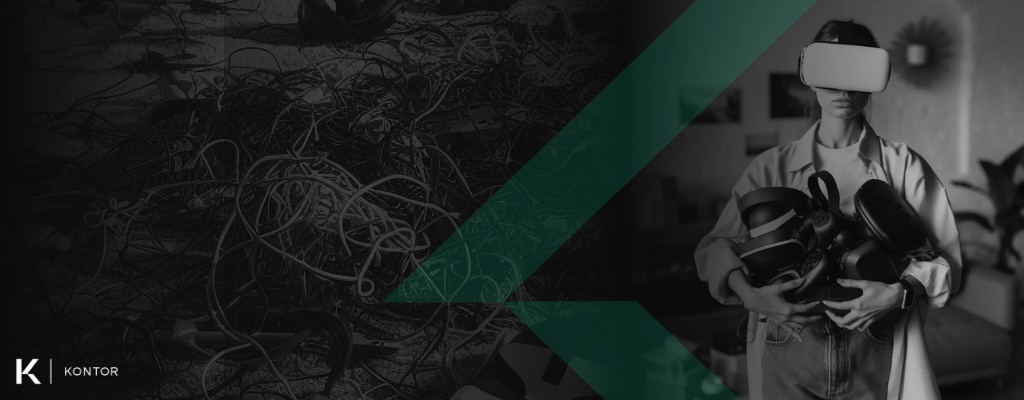What is mixed reality (MR)?

TL;DR: Mixed reality (MR) is a combination of augmented reality (AR) and virtual reality (VR). Via a head-mounted display (HMD), MR devices typically scan the environment and overlay virtual objects that react or adapt to physical and virtual inputs. The spectrum of MR exists across the virtuality continuum — from simple interactive overlays, to the physical room appearing to transform into another world, to the near fully virtual where only some parts of the physical world impact the virtual one.
— — — — —
Mixed reality (MR) combines virtual reality (VR) and augmented reality (AR), blurring the lines between digital and physical worlds. Across the spectrum from fully digital to fully physical, MR is where the digital and physical overlap and interact. But the lines between VR, AR, and MR have begun to blur.
Head-mounted displays (HMD) are evolving at a rapid pace, and with that they’re providing experiences that weren’t available in the recent past. Devices like the Meta Quest 3 deliver VR, AR, and MR capabilities right out of the box. And because access is widespread, physical world overlays aren’t limited to a heads-up-display-style, fixed, or static element.
We’ve already briefly discussed what MR is in a previous blog — What’s the difference between virtual reality, augmented reality, and mixed reality? Now we’ll dive deeper to understand MR’s role in extended reality (XR), how MR merges real and virtual worlds, its benefits, and considerations for selecting the right accessories.
— — — — —
Understanding extended reality (XR)

Before diving in, it’s essential to understand extended reality as a concept. XR is the umbrella term encompassing virtual, augmented, and mixed reality. Mixed reality is a combination of virtual and augmented reality.
First, we’ll revisit how both VR and AR are defined:
- Virtual Reality (VR): VR completely immerses the user in a computer-generated environment. Within a VR application, the device removes the physical world from the user’s field of view. They interact with the environment using controllers or sensors.
- Augmented Reality (AR): AR enhances the user’s view of the natural world with digital elements. Devices like smartphones or smart glasses add computer-generated images, videos, or data over what you see, often connected to physical objects or locations.
Extended reality, mixed reality, and the virtuality continuum

Image by the Interactive Design Foundation | Interaction-Design.org
Extended reality (XR) is the catch-all term that includes VR, AR, and MR technologies. MR is a combination of VR and AR. Where many get confused is the difference between AR and MR. The key distinction is that MR provides an experience where digital and physical elements can interact. AR simply overlays digital elements above the physical world. However, the capabilities of VR, AR, and MR all exist across a concept called the virtuality continuum.
XR ≠ virtuality continuum. Virtuality continuum ≠ MR
The virtuality continuum is a theory introduced by Milgram and Kishino in 1994. The continuum describes where experiences exist between the 100% real environment and the 100% virtual environment. MR experiences span the virtuality continuum and exist anywhere except for the extreme ends.
— — — — —
How mixed reality merges real and virtual worlds

Mixed reality’s standout feature is its ability to blend the virtual and physical worlds. This blend is made possible through a mix of hardware and software:
- Spatial mapping: MR devices use sensors like depth cameras and laser scanners to create a 3D map of the environment. This helps position virtual objects accurately in the real world.
- Real-time tracking: MR devices constantly track your position and orientation relative to the physical environment and virtual objects. This ensures virtual things stay in sync with your movements and location.
- Pass-through: Functionality allowing users to see the natural world through an HMD, enabling the interaction of digital content and the physical world.
— — — — —
Benefits of mixed reality

MR offers a range of benefits for both consumers and enterprises. This technology is revolutionizing how we work, learn, and experience the world around us. Below are examples of notable advantages:
Enhanced interaction
MR allows users to interact with digital content in their physical surroundings. This provides a heightened level of engagement and interactivity. Individuals can manipulate and control virtual objects as if they were physically present, creating new possibilities in fields such as education, entertainment, and training.
Real-time collaboration
There is a significant advantage in facilitating real-time collaboration using MR. It bridges the gap between remote teams and individuals by creating shared virtual spaces where people can work together, no matter where they are. This improves productivity, creativity, and efficiency while reducing travel costs and time constraints associated with face-to-face interactions.
Practical applications across industries
MR is already in us across various industries. In healthcare, surgeons can have a patient’s data overlaid onto their field of view during procedures, enhancing their awareness while reducing risk. In automotive, engineers in a manufacturing facility can collaborate with colleagues, interacting with full-size digital models.
— — — — —
Considerations for choosing MR accessories

Choosing the right accessories for your device requires consideration of several factors. Users need to identify the right features to meet the demands of the MR applications they intend to use. Here are the most crucial factors to consider:
Features
Consider the problems you may encounter — are you a marathon gamer? If so, you may need a battery pack. Do you plan on sharing the device? If you do, accessories need to be ideal for each user. Often, accessories have additional features that can provide added value. Identify the problems you may confront, prioritize based on your needs, and weigh any additional feature that may be included.
Style
HMD accessories, just as those in other categories, offer a variety of colors and designs to customize your device’s appearance. Choose those that complement your style and enhances your setup’s aesthetic appeal.
Comfort
It doesn’t matter how great your HMD is or the applications you plan to use are if you’re not comfortable. If you’re not comfortable, you won’t use your MR-equipped device as often or as long as you otherwise would. Your device should be outfitted with a facial interface (some call it a gasket or front pad), head straps, and/or padding that increases comfort and wear-time while meeting your specific requirements.
Price
First, determine a realistic budget. Keep in mind that (with few exceptions) good products aren’t cheap and cheap products aren’t good. Research different brands and models, review materials used, and compare prices and features. Look for the right balance between quality, value, and cost.
Compatibility
For the unaware — double-check that any tech accessory you purchase is compatible with your specific device.
— — — — —
Conclusion

Mixed reality has grown in popularity due to its increasing availability for consumers and benefits for organizations. By blending the digital and physical worlds, MR offers unique and immersive experiences previously unimaginable.
In business, MR can boost productivity, improve training retention, expand collaboration, enhance awareness, and much more. At home, people are using devices like Meta Quest 3 to play interactive desktop games, transform their home to a faraway land, and interact with virtual, AI-powered characters.
As technology advances, so will MR, and the lines between real and virtual will blur even further. We’ll see MR functionality in glasses or contact lenses, computers, cars, and in areas we can’t yet fathom. Only time will tell but one thing is certain — if you’re able, experience mixed reality first-hand. This introduction will help you understand MR as a concept, but nothing beats experience.
— — — — —
About Kontor
Kontor is a premium accessories brand for virtual and augmented reality. We enable extended use times and less distractions from the physical world through accessories that deliver supreme wearability.
Our team was born out of ResMed, a leading medical device manufacturer that transforms care for people with sleep and breathing conditions. We have over 30 years of anthropometric design observation and expertise and uniquely understand facial geometry and skin science.
If you’d like to discuss partnering with Kontor, fill out our online contact form and we’ll be in touch.
To stay up to date with what Kontor is working on, sign up for notifications at the bottom of this page.
